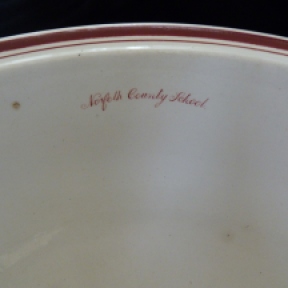Over the past couple of weeks, I have had the pleasure of exploring and engaging with Gressenhall Farm and Workhouse as part of my work placement for the Prince’s Trust team programme. Having toured museums in the past, I have always been intrigued by the extent of time and effort that must be invested by individuals behind the scenes. It has therefore been very interesting and rewarding to work with a diversity of subdivisions based around the Gressenhall site, including collections, the learning team, those maintaining the farm and front of house.
For example, I have thoroughly enjoyed participating in the categorisation and movement of collected items either displayed in the museum or held in storage. This involved learning about how to safely handle and pack away aged objects, how to enter and update digital item records on the museum’s Modes system and how to draw relevant nuggets of information from original scanned paperwork (such as minutes taken from meetings between the board of guardians back in 1843). In contrast, I also spent a day working down on the nearby farm, where I got the fantastic opportunity to groom one of the Suffolk Punch horses kept onsite and interactively learn about the intricate (and surprisingly mathematical) planning involved in turning soil with a horse-drawn plough.
 A display case of workworking tools I helped to process and pack
A display case of workworking tools I helped to process and pack
Horse-drawn ploughing in action
Prior to beginning my placement, I was unaware that the museum supported such a dedicated learning department, so it was educational in itself to join a school party of year 5s and shadow the team as they delivered a day-long event teaching about different aspects of Neolithic Britain. I was certainly impressed with the highly interactive nature of the four planned sessions – from throwing spears as part of a hunting party to engaging in a treasure hunt centred around the museum’s Neolithic exhibits – but also how inclusive the integrated talks were. The children were always encouraged to think for themselves by answering frequently posed questions, rather than simply listen to a wall of Neolithic facts. Later on in my placement, I was able to assist in preparations for a number of upcoming Victorian family Christmas events, setting aside arts and crafts materials for activities focused on making paper chains and peg dolls.
In addition, I also had the opportunity to shadow the front of house team as they supervised the site and carried out maintenance at a time where the workhouse and farm is closed to the public for the winter. This allowed me to learn about many different performed procedures, such as how visiting school groups are accounted for upon arrival and billed or how to correctly test fire and safety systems installed within the collections gallery, workhouse building and farm. I was also lucky enough to visit the Norfolk collections centre located onsite and inspect many of the amazing objects stored inside, such as a euphonicon (19th century upright piano) and the West Runton Mammoth tusk.
My handiwork preparing felt for the Victorian family christmas peg dolls
Admiring Gressenhall’s own version of the Indiana Jones Hangar 51 warehouse
All in all, I think that my experience of the numerous roles operating at Gressenhall has been enhanced by the fact that everybody has been so friendly, willing to demonstrate how they approach their tasks and informative in explaining their perspective with regards to the realistic expectations and difficulties of maintaining an engaging and inviting museum. So to everyone I have spoken with and worked alongside at Gressenhall Farm and workhouse, you’re doing a grand job and I’ve really enjoyed my time spent working here. You have my thanks.
Christopher Cox



























































